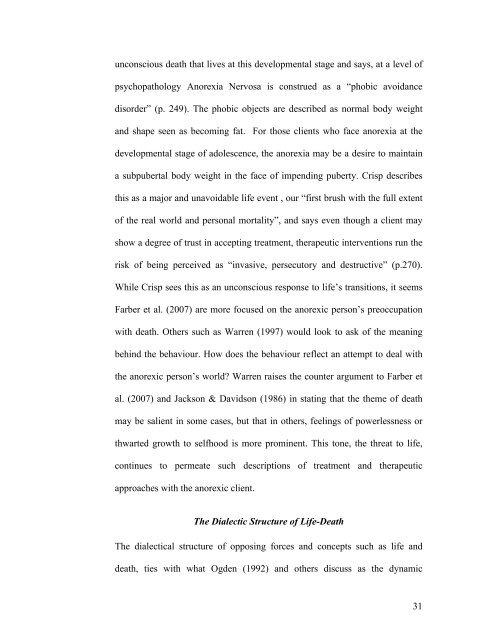“Ghosts at the banquet” - Scholarly Commons Home
“Ghosts at the banquet” - Scholarly Commons Home
“Ghosts at the banquet” - Scholarly Commons Home
Create successful ePaper yourself
Turn your PDF publications into a flip-book with our unique Google optimized e-Paper software.
unconscious de<strong>at</strong>h th<strong>at</strong> lives <strong>at</strong> this developmental stage and says, <strong>at</strong> a level of<br />
psychop<strong>at</strong>hology Anorexia Nervosa is construed as a “phobic avoidance<br />
disorder” (p. 249). The phobic objects are described as normal body weight<br />
and shape seen as becoming f<strong>at</strong>. For those clients who face anorexia <strong>at</strong> <strong>the</strong><br />
developmental stage of adolescence, <strong>the</strong> anorexia may be a desire to maintain<br />
a subpubertal body weight in <strong>the</strong> face of impending puberty. Crisp describes<br />
this as a major and unavoidable life event , our “first brush with <strong>the</strong> full extent<br />
of <strong>the</strong> real world and personal mortality”, and says even though a client may<br />
show a degree of trust in accepting tre<strong>at</strong>ment, <strong>the</strong>rapeutic interventions run <strong>the</strong><br />
risk of being perceived as “invasive, persecutory and destructive” (p.270).<br />
While Crisp sees this as an unconscious response to life’s transitions, it seems<br />
Farber et al. (2007) are more focused on <strong>the</strong> anorexic person’s preoccup<strong>at</strong>ion<br />
with de<strong>at</strong>h. O<strong>the</strong>rs such as Warren (1997) would look to ask of <strong>the</strong> meaning<br />
behind <strong>the</strong> behaviour. How does <strong>the</strong> behaviour reflect an <strong>at</strong>tempt to deal with<br />
<strong>the</strong> anorexic person’s world? Warren raises <strong>the</strong> counter argument to Farber et<br />
al. (2007) and Jackson & Davidson (1986) in st<strong>at</strong>ing th<strong>at</strong> <strong>the</strong> <strong>the</strong>me of de<strong>at</strong>h<br />
may be salient in some cases, but th<strong>at</strong> in o<strong>the</strong>rs, feelings of powerlessness or<br />
thwarted growth to selfhood is more prominent. This tone, <strong>the</strong> thre<strong>at</strong> to life,<br />
continues to perme<strong>at</strong>e such descriptions of tre<strong>at</strong>ment and <strong>the</strong>rapeutic<br />
approaches with <strong>the</strong> anorexic client.<br />
The Dialectic Structure of Life-De<strong>at</strong>h<br />
The dialectical structure of opposing forces and concepts such as life and<br />
de<strong>at</strong>h, ties with wh<strong>at</strong> Ogden (1992) and o<strong>the</strong>rs discuss as <strong>the</strong> dynamic<br />
31
















